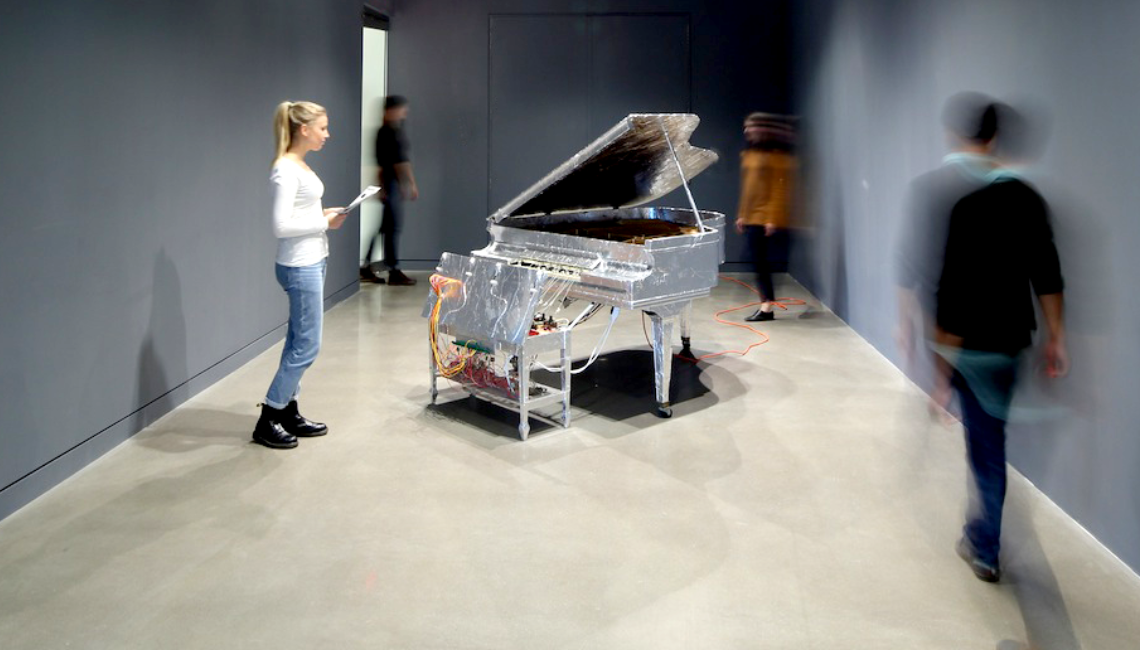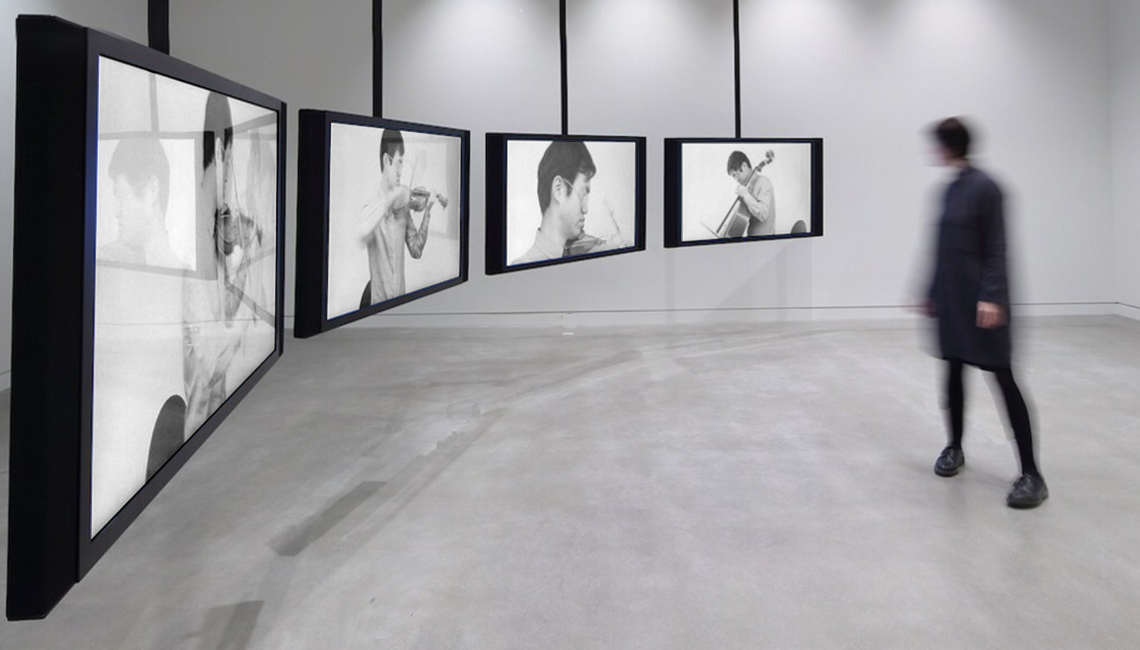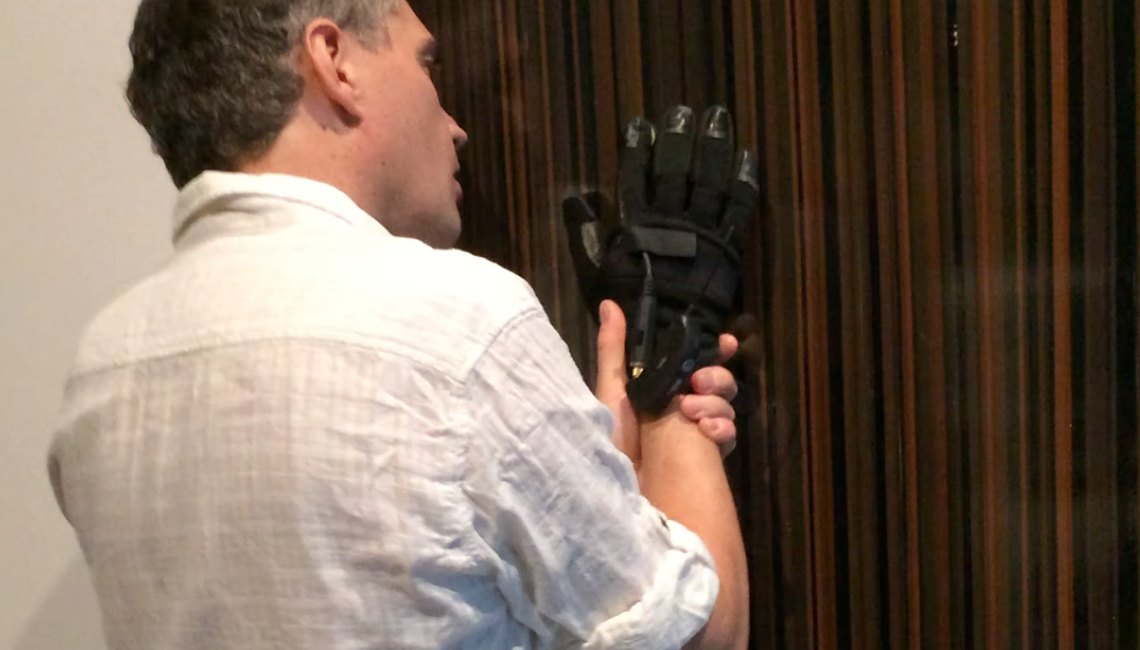M U S I C I R C U S
September 12 - November 16, 2014
It was November 1967 and the cavernous Stock Pavilion was alive with sound. Radical artist-music-sound-maker John Cage had corralled 100’s of composers, musicians, artists and performers to play music, make art, and perform, all simultaneously, to an invited audience who were themselves conceived as part of the act. The result was a wild turbulence of music, projected image, installation and performance. John Cage called this event Musicircus; not a performance, but a groundbreaking happening.
Forty-seven years later John Cage is inescapable. His influence extends to all creative spheres; he is a ubiquitous presence. His revolutionary experiments in musical structure, his creation of unconventional instruments, a persistent questioning of authenticity and originality...the very question of where music, musicianship and performance begins and ends...all find their place in this exhibition. So too does his love of hybrid sound.
This Musicircus brings together a small but extraordinary group of artists who explore and deconstruct the language of music. They have all captured and even influenced an ever-evolving relationship between art and technology. This exhibition allows sound and works to intersect and collaborate in random and captivating ways. For eight weeks, four works by Jean-Pierre Gauthier, Christian Marclay, Tim Lee and Signal-to-Noise form part of the New Media Gallery Musicircus.
Forty-seven years later John Cage is inescapable. His influence extends to all creative spheres; he is a ubiquitous presence. His revolutionary experiments in musical structure, his creation of unconventional instruments, a persistent questioning of authenticity and originality...the very question of where music, musicianship and performance begins and ends...all find their place in this exhibition. So too does his love of hybrid sound.
This Musicircus brings together a small but extraordinary group of artists who explore and deconstruct the language of music. They have all captured and even influenced an ever-evolving relationship between art and technology. This exhibition allows sound and works to intersect and collaborate in random and captivating ways. For eight weeks, four works by Jean-Pierre Gauthier, Christian Marclay, Tim Lee and Signal-to-Noise form part of the New Media Gallery Musicircus.
Curation + Design: Sarah Joyce + Gordon Duggan
Jean-Pierre Gauthier
Biography
Jean-Pierre Gauthier’s practice spans visual arts, experimental music and sound. Battements et Papillons has been described as ‘transforming everyday objects into living, moving, singing organisms’.
Gauthier lives in Montreal. He is winner of the prestigious Sobey and Victor Martyn Lynch-Stauton Awards as well as the Louis Comtois Award. He exhibits worldwide, and has been written about in diverse publications. Battements et Papillons is on loan to the New Media Gallery courtesy of the Musée d’art contemporain, de Montréal (MACM).
Gauthier lives in Montreal. He is winner of the prestigious Sobey and Victor Martyn Lynch-Stauton Awards as well as the Louis Comtois Award. He exhibits worldwide, and has been written about in diverse publications. Battements et Papillons is on loan to the New Media Gallery courtesy of the Musée d’art contemporain, de Montréal (MACM).
Image

Battements et Papillons 2006
Gauthier’s inventive and often wistful body of work often incorporates or creates instruments and sound-making paraphernalia. His objects escape their boundaries: breaking free from the confines of their own bodies, delineating and animating the gallery space, seeking order from chaos. Battements et Papillons is one of Gauthier’s earlier works, produced two years after winning the prestigious 2004 Sobey Award.
A prepared piano takes centre stage in a theatrically lit room, set apart from the viewer. It gives a solitary performance, released from its human performer. Yet it remains connected and interconnected; a tangle of wires, solenoids & electronics link the pianist’s bench to the body of the piano. The piano is never touched by human hands, yet it is responsive to those who pass through the gallery. Sensors pick up body movement and heat, generating what appear to be deliberately melodic fragments that are in fact random. Cables are inserted into minor keys chosen for the dolorous quality of their sound. The surface of the piano has been excavated, ground raw...then bandaged with silver, becoming a glittering memento mori.
Credits
Jean-Pierre Gauthier, Montreal
Battements et Papillons 2006
Musée d’art contemporain, de montréal (MACM)
Battements et Papillons 2006
Musée d’art contemporain, de montréal (MACM)
Tim Lee
Biography
Lee is one of a significant number of Vancouver artists whose works are highly regarded in international circles. He has won the prestigious Sobey, VIVA and DAAD Awards. He shows internationally and his work can be found in many of the world’s most prestigious collections. The work is on loan to the New Media Gallery from the Lisson Gallery in London, UK.
Image

String Quartet, Op. 1, Glenn Gould, 1955 2010
Lee has reconstructed and referenced a key historical moment in the history of music. He has reconstructed and reimagined the process of another to help him fathom and delineate his own process. This ‘other’ is Canadian composer, Glenn Gould, known for innovative editing techniques to control excellence in the studio, rather than through live performance. The title references the year that Gould published his first and only composition for string quartet.
String Quartet, Op. 1, Glenn Gould, 1955 is an absorbing exploration into the flexible and contingent nature of creativity, authenticity and originality. It also delves into the realm of the absurd. The visually austere, four-screen work hangs low in a brightly lit room. Approached from behind; one hears the restricted palette of the string quartet before they are seen. On screen we are confronted with Lee himself...at once every member of this string quartet. While the plausibility of a solitary virtuoso might be acceptable, we immediately notice the fragmented quality of the video, and begin to question the uncertain and ironic nature of this ‘performance’. Lee, who is barely competent with each instrument, recorded the composition note by note, with assistance, editing the frames together to realize a complete performance. He has taken Gould’s interest in editing to the apogee. The work explores and comments on the role of technology in artistic process, on the definition of originality and on sense of agency.
String Quartet, Op. 1, Glenn Gould, 1955 is an absorbing exploration into the flexible and contingent nature of creativity, authenticity and originality. It also delves into the realm of the absurd. The visually austere, four-screen work hangs low in a brightly lit room. Approached from behind; one hears the restricted palette of the string quartet before they are seen. On screen we are confronted with Lee himself...at once every member of this string quartet. While the plausibility of a solitary virtuoso might be acceptable, we immediately notice the fragmented quality of the video, and begin to question the uncertain and ironic nature of this ‘performance’. Lee, who is barely competent with each instrument, recorded the composition note by note, with assistance, editing the frames together to realize a complete performance. He has taken Gould’s interest in editing to the apogee. The work explores and comments on the role of technology in artistic process, on the definition of originality and on sense of agency.
Credits
String Quartet, Op. 1, Glenn Gould, 1955 2010
Courtesy the artist and Lisson Gallery London. UK
Courtesy the artist and Lisson Gallery London. UK
Christian Marclay
Biography
Marclay is an explorer and storyteller who seems happy to ignore traditional boundaries. With little formal training in music and a strong background in the visual arts he has successfully blurred the boundaries of music, visual arts and performance. His work is exceptionally innovative. He was a pioneer of sound collage and sampling in the 80’s. He has been described as ‘the most exciting collagist since Robert Rauschenberg’. While living in NYC in the 80’a he became one of the first scratch DJ’s. He collaborates with musicians worldwide, has been collected and exhibited by most major galleries and art museums, has won countless accolades including the coveted Golden Lion at the Venice Biennale, 2011. He was recently named one of the ‘Ten most important artists of today’ by Newsweek and is one of Time Magazine’s ‘Time 100’. Marclay now lives and works in London, UK. Commissioned by the San Francisco Museum of Art, Video Quartet is one of the treasures of the William and Ruth True Collection.
Image
Video Quartet
Video Quartet is one of Christian’s Marclay’s most significant and enchanting works; described once as a ‘beguiling dream of eternal cinema’. The 4-screen, synchronized video and sound installation is an impressive reimagining of cinematic and musical language. In an acoustically shrouded gallery the work fills a 40’ wall and surrounding space with a decoction of filmic moments and sound fragments. Hundreds of film have been selected and restructured into a joyful, identifiable, dreamy, brawling musi-visual pageant. From the raw material of film Marclay has created a musical composition that defies common definitions of originality. The work recalls cinematic history, reinvents narrative arcs and repositions melody and musical structure. It is a bravura performance.
Credits
Christian Marclay, London, UK
Video Quartet 2002
Western Bridge, William and Ruth True Collection, USA
Video Quartet 2002
Western Bridge, William and Ruth True Collection, USA
Signal to Noise
Biography
The collective Signal-to-Noise (Oliver Wilshen and Niall Quinn). explore the materiality of dead media artefacts. Their work is manifested through direct and playful interaction. The duo create unconventional instruments that question the nature and meaning of performance, originality and memory.
They have produced award-winning work, they exhibit internationally and are published widely.
They have produced award-winning work, they exhibit internationally and are published widely.
Image

Analogue Tape Glove
As their name implies, Signal-to-Noise dismantles and reconstructs technology (signal) to produce sound and music (noise). Analogue Tape Glove is literally hands-on. Wearing a modified glove with a magnetic tape head embedded in one finger, the viewer is encouraged to make contact with a brown-striped panel hanging on the wall. The panel is actually composed of hundreds of carefully applied strips of found magnetic audiotape. Many of these strips are the ubiquitous cassette tape. Even those not familiar with this old technology quickly realize the sound emerging from the speakers derives from contact with the tape. Squeaks, riffs and feedback whines are coaxed forth by contacting finger to strip and then running it up and down. As with any new instrument patience and practice lead to improvement in technique. Uncanny and sometimes recognizable remnants of music and subtle voice fragments emerge from the surface.
Credits
Signal-to-Noise [Oliver Wilshen and Niall Quinn] , Brighton, UK
Analogue Tape Glove 2009
Private Collection, UK
Analogue Tape Glove 2009
Private Collection, UK
